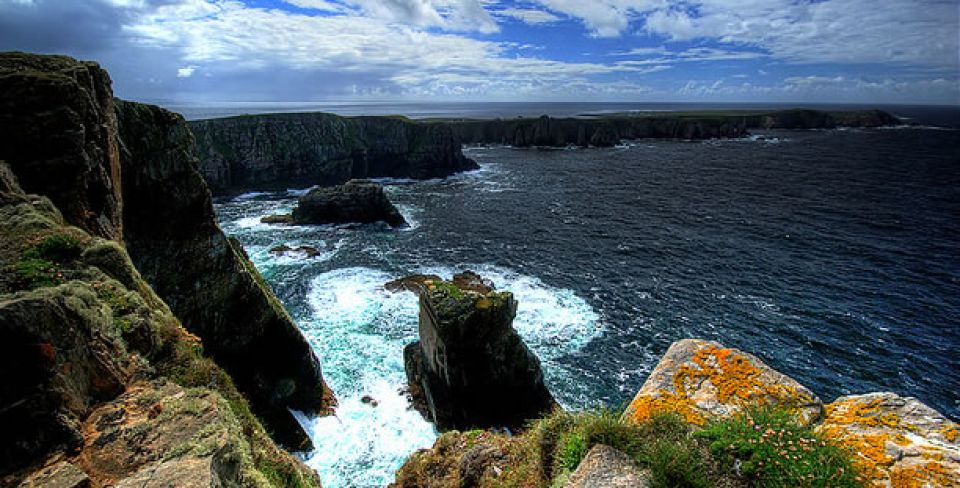
Cloughaneely and Tory Island
Head to north-west Donegal to discover Tory Island and its traditional links with Colmcille.
Nine miles across the Tory Sound, Tory is the most remote of Ireland’s inhabited islands. It is just 2 1/2 miles long and 3/4 mile wide, and is home to over 100 people.
The island has a long history of human inhabitation and has archaeology dating back to the Iron Age. There are also Christian remains dating back to early medieval times.
Tory Island is also home to the mythical Balor of the Mighty Blows – a one-eyed king. The eye was so evil that it had to be kept covered. A prophecy told that Balor would be killed by his grandson so he locked his only daughter Eithne in a big stone tower – Tor Mór. But Eithne still managed to produce a son – Lúgh – who fulfilled the prophecy by killing his grandfather.
Lúgh is taken as a symbol of goodness and light fighting against the evil Balor. He was known in many parts of Celtic Europe as a powerful god. It seems likely that in Christian times some of the attributes of Lugh were transferred to the character of Colmcille.
Getting There
The Tory ferry service runs from the pier at Magheroarty – Machaire Rabhartaigh. The timetable changes according to the season and crossings can be cancelled at short notice due to changing weather so please check before you travel.
Please note that the ferry is passenger-only.
From Letterkenny, take the N56 towards Dunfanaghy. Continue on through Falcarragh and Gortahork. Past Gortahork follow the R257 coast road to Magheroarty. There is parking by the pier.
Coming from Gweedore, take the R258 towards the coast at Bunbeg and turn right on to the R257 following the road round to Magheroarty.
Cloughaneely and Tory Island
- 2.1 An Chros Tau
As you arrive in Tory the first site to greet you is the Tau Cross. Sitting high on a plinth, the T-shaped stone cross is a symbol of the island’s Christian heritage. The cross is thought to date from early medieval times and is carved from one piece of mica...
- 2.2 The Old Graveyard
The graveyard is believed to be on the site of an Teampull Buí which was the main church of a former monastery on Tory. An early Ordnance Survey map shows the remains of ‘St Columkille’s church’ in the southwest corner of the graveyard although no remains are visible today. There are many...
- 2.3 The Bell Tower
The Bell Tower is the only surviving round tower in Donegal. Although it's nearly 13 metres tall, it is among the smallest of these towers in Ireland. Its date is not known but could be as late as the 12th century. The granite stones used to make the tower would...
- 2.4 St John’s Altar
This altar dedicated to St John the Baptist is just beside the Bell Tower. There are a number of stones here - including a stone trough, decorated stones and slabs, a quern (millstone) and the remains of the base of a cross. It is said that the hollow stones were used...
- 2.5 St Brigid’s Oratory
The stone altar of St Brigid lies between the islanders’ houses. On top of the altar are three quern stones (used for grinding corn) and two granite slabs. As well as Ulaí Bhríde there are remains of two other small chapels - or oratories - on the island. At one...
- 2.6 Church of the Seven
These are the only chapel remains on Tory Island. In Irish this place is called Móirsheisear which translates as ‘big number six’ and which is an old Irish word for the number seven. Islanders tell the story that the site is the tomb of seven people who drowned when their boat was...
- 2.7 Rock of the Hound
© Alan Sproull Local tradition says that when Colmcille first arrived at Tory island he was met by the local king Oilill who refused to let him land. Colmcille asked if he could simply have a piece of land the same size as his cloak on which he could build...
- 2.8 Cnoc Na Naomh
Local legend says that Colmcille stood on this hill - Cnoc na Naomh - with his companions Saints Fionán, Dubthach and Begley. As they stood here above Magheraroarty, they discussed who would have the task of converting the Tory islanders to Christianity. They decided to answer the question by throwing...
- 2.9 Ray Church
Ray (pronounced ‘Rye’ in Irish, Ráith), is an ancient church site remarkable for its links with the abbey of Iona, and for its very tall high cross - 5.56m, one of the tallest if not the tallest in Ireland. The church stands on the east bank or the river Ray...
- 2.10 Tullaghobegley
The ruins of the late medieval Tullaghobegley Church and graveyard lie on a small mound just to the south of Falcarragh. This tulach - or ‘low hill’ or ‘mound’ - was probably used for tribal inauguration ceremonies or other gatherings. Remains of other ancient monuments can be found nearby including burial grounds,...










Bòrd na Gàidhlig
Great Glen House
Leachkin Road
Inverness
Scotland, IV3 8NW
(+44) 01463 225454
colmcille@gaidhlig.scot
Colmcille
Foras na Gaeilge, 2-6 Queen Street
Belfast
Northern Ireland
BT1 6ED
(+44) 028 9089 0970
colmcille@forasnagaeilge.ie
Colmcille
Foras na Gaeilge, An Chrannóg
Na Doirí Beaga
Gaoth Dobhair
Donegal, Ireland. F92 EYT3
(+353) 074 9560113
colmcille@forasnagaeilge.ie

